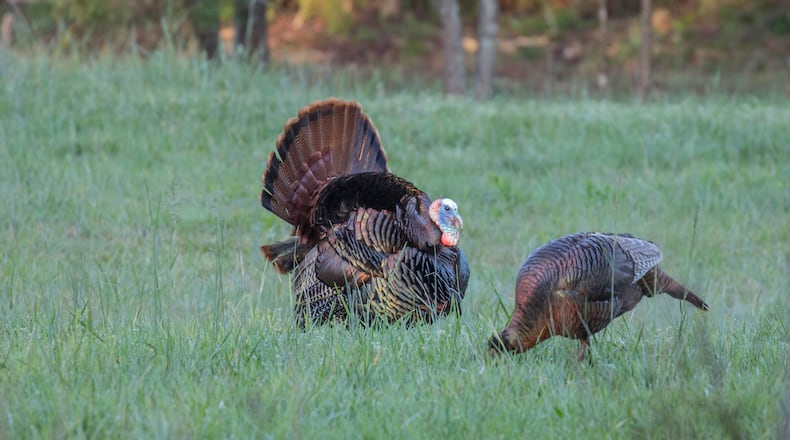There’s no problem spotting turkey at your local grocery — U.S. farms produce more than 200 million of the fowl a year, many of them to be carved up for Thanksgiving and Christmas.
But in some parts of the nation it’s increasingly difficult to find the big bird in nature — including in Georgia, where the wild turkey is the second most popular animal to hunt behind deer.
Some researchers don’t think the main culprit is overhunting, instead blaming the shrinking wild population mostly on habitat loss and nonhuman predators.
Still, they are working to understand why turkeys are still thriving in parts of the country while having nose dived in others.
Trying to get to the bottom of that mystery and others are investigators like Professor Michael Chamberlain, aka “the Wild Turkey Doc,” and his graduate students at the University of Georgia.
His team has outfitted wild turkeys with small backpacks to track their movements. Separately, the researchers record and analyze 100,000 hours annually of turkey sounds, from gobbling to yelps, in states from Florida to Nebraska.
“I want to see their populations be sustainable because I value not only the bird, but the places they call home,” Chamberlain said.
Credit: Charles Seabrook
Credit: Charles Seabrook
Roller coaster ride for ‘Bird of Courage’
Wild turkeys nationwide have had an up and down flight path. From Colonial times to the 1920s, their numbers fell so precipitously that people feared they had disappeared from most of their broad native range. Decades of restoration efforts triggered a remarkable comeback.
By 1973 there were an estimated 1.25 million of the birds in the wild, according to the National Wild Turkey Federation. Their numbers are believed to have peaked at about 7 million in the early 2000s. Now, the federation says, there are an estimated 6.25 million.
But the falloff has been more significant in much of the Southeast and Midwest.
In the early 2000s, the Georgia Department of Natural Resources estimated there were about 350,000 wild turkeys in the state. The department no longer produces estimates, but Emily Rushton, a DNR wildlife biologist, suspects Georgia’s current population is probably around 200,000 now.
And the wild turkey population is still declining in certain parts of the state, particularly in the sprawling, increasingly developed Piedmont region, from the Columbus and Macon areas to the foothills of northeastern Georgia and around metro Atlanta, she said.
The picture is very different in some other parts of the country, including on the outskirts of major cities. People in the Northeast, for example, have reported sometimes scary run-ins with the strutting creatures Ben Franklin once described as “a Bird of Courage.” Male wild turkeys, known as gobblers, can weigh about 20 pounds and stand 2½ feet tall. Females, called hens, often weigh half as much.
In Massachusetts, wildlife officials this year warned residents that turkeys “may attempt to dominate or attack people that they view as subordinates,” particularly during the spring breeding season. To scare off overly aggressive turkeys, the state’s wildlife division suggested making loud noises and spraying them with water from a hose. Another option: posting “Mylar tape, balloons, or pinwheels” on property to deter the birds.
Georgia’s turkey hunting heads south
In Georgia, the number of the turkeys killed during the state’s spring hunting seasons has dropped sharply in the last 20 years. And the number of poults — very young turkeys — per hen has been hovering at levels less than half what they were in the late 1990s and early 2000s, according to the DNR’s Rushton.
Human hunters have gotten more effective at bagging wild turkeys, said Chamberlain, who is an avid turkey hunter in addition to being a professor at UGA’s Warnell School of Forestry and Natural Resources. He cited improvements in camouflage, firearms and ammunition, as well as the ease of finding online videos that offer expert tips on hunting the birds.
The hunting season for turkeys is designed to take place during the species’ breeding season. Hunters hunker down and use calls to trick male birds gobbling along, thinking they are heading for a receptive hen.
The timing has created concern that hunting disrupts the breeding cycle of a species in decline. Georgia’s DNR in recent years shortened the turkey hunting season on public land, delaying its start by roughly a couple weeks to give more of the birds a chance to breed. Georgia also reduced the number of turkeys that hunters are allowed to kill in a season from three to two.
“We’re trying to find the balance of maintaining turkey hunting as a sport and making sure it is not affecting the population,” Rushton said.
But Chamberlain and Rushton, who also hunts wild turkeys, do not think hunting is the principal reason behind the bird’s overall decline in nature, though it can have an impact.
Fewer shrubs, prowling coyotes and raccoons take toll
Chamberlain points to the loss of just the right diverse forests, including hardwood trees as well as succulent green vegetation, shrubs, grasses and just the right amount of undergrowth that young turkeys can easily scurry below while mother hens can still keep an eye on them.
“Turkeys thrive in plant communities that a host of other species also thrive in, such as many songbirds. A lot of those species are also in decline,” said Chamberlain, who became fascinated with turkeys and their behavior while hunting with his father.
New housing developments, spreading industry, roads, cleared power line and utility easements and more intense commercial forestry and farming operations have eliminated and isolated habitats that work best for wild turkeys and some other wildlife, researchers said.
At the same time, according to Chamberlain, they’ve made turkeys and other creatures easier targets for predators, such as coyotes. Turkeys make their nests on the ground. Young birds are particularly vulnerable.
Credit: CURTIS COMPTON / AJC
Credit: CURTIS COMPTON / AJC
With the challenges for turkeys in mind, Georgia legislators in 2022 approved a bill allowing hunting and trapping of raccoons, another predator, year round.
But some wildlife experts haven’t been convinced the changes will have a broad impact on the state’s overall turkey population. There are also limits to the DNR’s options for making large-scale shifts affecting the turkey’s habitat because most hunting takes place on private lands.
And it remains unclear exactly why their numbers continue to grow in some parts of the country but shrink in others.
While researchers continue to dig for clues, Chamberlain said he will spread more videos online showing private property owners what good habitats for wild turkeys look like, with hopes that some will make changes to their land.
Each Tuesday, he also posts online tidbits about turkeys, hoping to keep people thinking about the birds year round. Recent subjects have included “Importance of Loafing for Wild Turkeys,” “Not All Toms are Equal When it Comes to Breeding Strategies,” “Gang Activity Among Jakes” (young male turkeys) and “Five Amazing Attributes of Wild Turkey Feathers.”
One superpower male turkeys have: an uncanny ability to hear a momentary call from a hen, pinpoint her exact location and travel to the spot from hundreds of yards away.
Chamberlain is helped by his team of grad students, whose studies have looked into how a never-hunted population of wild turkeys act, variances in the survival of male turkeys with different personality types (fast versus slow explorers) and the effect of the personalities of different hens on nesting strategies and reproductive success.
“I have students studying almost every topic you can think about,” he said.
But he has his limits when it comes to turkeys, particularly ones raised on farms.
Come Thanksgiving, Chamberlain isn’t expecting to be eating turkey. He and his family typically change their menu up, from having seafood to dining on smoked ribs. At other times of the year, though, he frequently eats wild turkey, which he said tends to be leaner and coarser than the meat of domesticated turkeys.
“I don’t remember the last time that we ate store-bought turkey … It’s been years.”
Wild turkey kills reported by hunters in metro Atlanta counties, spring 2024 season:
Cherokee — 150
Clayton — 3
Cobb — 17
DeKalb — 1
Douglas — 17
Fayette — 10
Forsyth — 12
Fulton — 34
Gwinnett — 0
Henry — 19
Paulding — 166
Rockdale — 13
Source: Georgia Department of Natural Resources
About the Author
Keep Reading
The Latest
Featured







